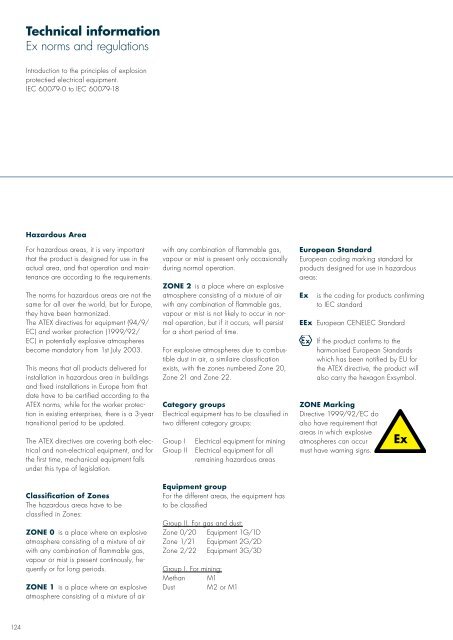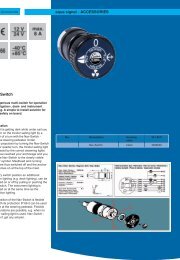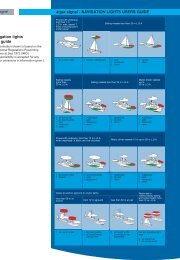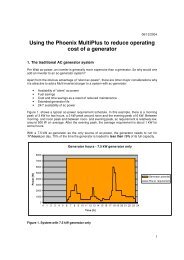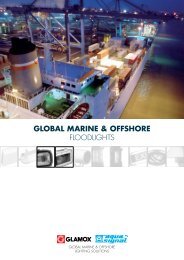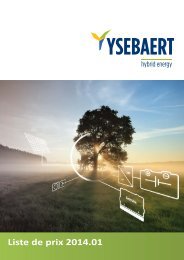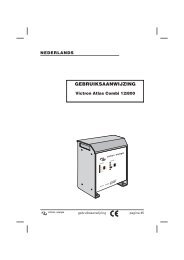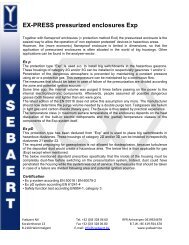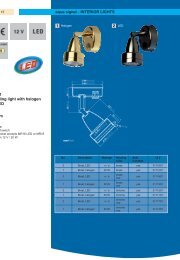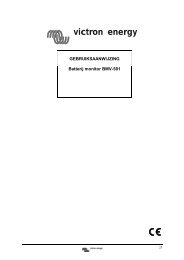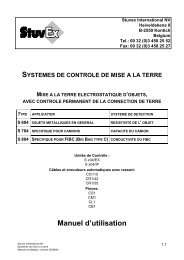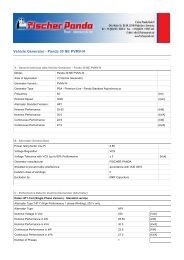navigation lights - Ysebaert
navigation lights - Ysebaert
navigation lights - Ysebaert
- No tags were found...
You also want an ePaper? Increase the reach of your titles
YUMPU automatically turns print PDFs into web optimized ePapers that Google loves.
Technical informationEx norms and regulationsTechnical informationMarking of explosion protected electrical apparatusIntroduction to the principles of explosionprotectied electrical equipment.IEC 60079-0 to IEC 60079-18Product and area marking according todirective 94/9/EC (ATEX)Hazardous AreaFor hazardous areas, it is very importantthat the product is designed for use in theactual area, and that operation and maintenanceare according to the requirements.The norms for hazardous areas are not thesame for all over the world, but for Europe,they have been harmonized.The ATEX directives for equipment (94/9/EC) and worker protection (1999/92/EC) in potentially explosive atmospheresbecome mandatory from 1st July 2003.This means that all products delivered forinstallation in hazardous area in buildingsand fixed installations in Europe from thatdate have to be certified according to theATEX norms, while for the worker protectionin existing enterprises, there is a 3-yeartransitional period to be updated.The ATEX directives are covering both electricaland non-electrical equipment, and forthe first time, mechanical equipment fallsunder this type of legislation.Classification of ZonesThe hazardous areas have to beclassified in Zones:ZONE 0 is a place where an explosiveatmosphere consisting of a mixture of airwith any combination of flammable gas,vapour or mist is present continously, frequentlyor for long periods.ZONE 1 is a place where an explosiveatmosphere consisting of a mixture of airwith any combination of flammable gas,vapour or mist is present only occasionallyduring normal operation.ZONE 2 is a place where an explosiveatmosphere consisting of a mixture of airwith any combination of flammable gas,vapour or mist is not likely to occur in normaloperation, but if it occurs, will persistfor a short period of time.For explosive atmospheres due to combustibledust in air, a similaire classificationexists, with the zones numbered Zone 20,Zone 21 and Zone 22.Category groupsElectrical equipment has to be classified intwo different category groups:Group IGroup IIElectrical equipment for miningElectrical equipment for allremaining hazardous areasEquipment groupFor the different areas, the equipment hasto be classifiedGroup II. For gas and dust:Zone 0/20 Equipment 1G/1DZone 1/21 Equipment 2G/2DZone 2/22 Equipment 3G/3DGroup I. For mining:Methan M1Dust M2 or M1European StandardEuropean coding marking standard forproducts designed for use in hazardousareas:Exis the coding for products confirmingto IEC standardEEx European CENELEC StandardIf the product confirms to theharmonised European Standardswhich has been notified by EU forthe ATEX directive, the product willalso carry the hexagon Exsymbol.ZONE MarkingDirective 1999/92/EC doalso have requirement thatareas in which explosiveatmospheres can occurmust have warning signs.ATEX labellingProducts certified according to ATEX also have the certification number as well as thecertification authority and year of certification on the label.For GFX floodlight you will find: PTB 03ATEX1114This states that the fixture is approved by PTB (notified body number 0102) in year 2003,according to ATEX and the number given is 1114.Symbol for explosionprotectionCategory(level of protection):1: Very high2: High3: NormalEquipment group:I: miningII: non-miningTemperature classesFor safety utilisation, the maximumtemperature of the product has to be lowerthan the ignition temperature of theType of protectionII 2 G Ex d e IIB T3 PTB 03ATEX1114Gas group(minimum ignition energy):I: MethaneIIA: Prophane (200µj)IIB: Ethylene (60µj)IIC: Hydrogen (20µj)Classification of maximum surface temperaturesfor Group II electrical apparatusTemperatureclassComplies with EuropeanEx-standardAtmosphere:D: DustG: GasMax. surfacetemperatureMaximum surfacetemperature:T1: 450 °CT2: 300 °CT3: 200 °CT4: 135 °CT5: 100 °CT6: 85 °Cinflammable gas or dust mixture. Basedupon this, the products have to beclassified into temperature classes.Ignition temperatureof combustible materialT1 450°C > 450°CT2 300°C > 300°CT3 200°C > 200°CT4 135°C > 135°CT5 100°C > 100°CT6 85°C > 85°CNotified BodyCertificate number124 125


